
May 1909, off the North Shore of Orcas Island, Washington State:
“As Baker ran he saw the water begin foaming out past the reef, and the head of a huge serpent rose from the roiling waters. Ten feet and more of the monster’s head surfaced, and his undulating body rose in and out of the water as it moved with incredible speed to Parker’s Reef. Shaggy, mane-like fronds ringed the monster’s neck behind the head, which resembled a large draft horse. A large dorsal fin about fifteen feet behind the head stood approximately six feet high, and moved from left to right as the creature swam onto the rocks.”
(Excerpt from “Dirty Elsie” by Tom Welch for the Orcas Island Historical Society, September 18, 2013, “The Island’s Sounder”)
Since the dawn of sea travel, man has told tales of startling, sometimes dangerous monsters from the oceans depth. Most are dismissed as myth, however such “Fish-tales” continue to this day, even right in our own neighborhood.
The Tom Welch article, excerpted above, describes just such an encounter. To me at the time, this legend appeared to be just that, another fish story. However, detailed sightings suggest the animal actually exists.
Here’s what’s interesting; these sea serpents have been seen hundreds of times since the 1800’s, and legend/folk history predates those sightings in West Coast Native lore.
Below is an ancient rock petroglyph depicting a sea serpent, found at Nanaimo B.C. :
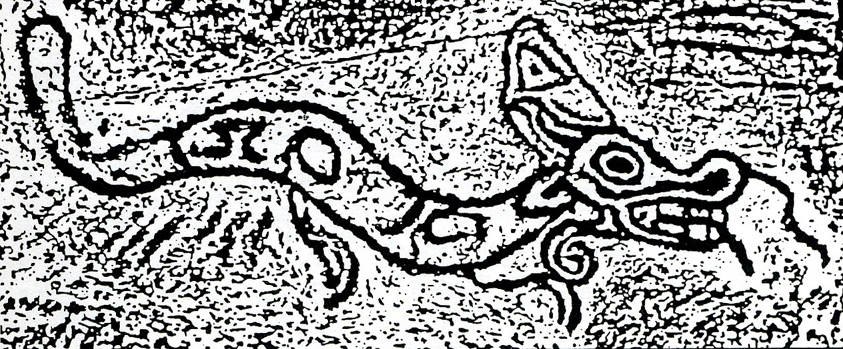
Credit – British Columbia Scientific Cryptozoology Club
http://cadborosaurus.ca/History-Facts.html
Additionally, the above link to BCSCC details a carved spear throwing tool, called an Atlatl, which clearly shows a depiction of what would later be called “Cadborosaurus”. That tool was carbon dated to be 1,700 years old.
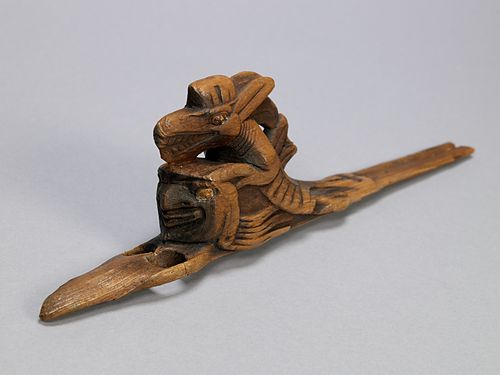
Credit: “The Skagit River Atlatl” https://qmackie.com/2010/10/07/the-skagit-river-atlatl/
It should be noted; the 1909 sighting on Orcas Island predated any local publication describing the animal, the first of which was in October 1933 by an editor named Archie Willis for “The Victoria Daily Times”.
In that article and subsequent articles, the creature was described as a serpent around sixty feet long, with a large head resembling variously a dog, horse or camel. After Willis “fished” around for a popular name, he settled on “Cadborosaurus” after Cadboro Bay near Victoria B.C.
Many sightings in the area refer to Cadboro Bay, and when marine experts began to shoehorn the beast into a taxonomic category, they honored editor Willis by naming the creature “Cadborosaurus Willisi”.
As located on maps, Cadboro Bay on Vancouver Island B.C. is just a few miles from San Juan County Wa., where the Orcas Island serpent was sighted in 1909, years before the publication of Canadian sightings.
Therefore, it seems, the later publications could not have influenced the sighting by men working near Parker Reef on Orcas Island.
The Orcas Island account described above was written by the late Tom Welch. It appeared in the September 18th 2013 issue of “The Island’s Sounder” in a small segment titled “History Nook” and was sponsored by The Orcas Island Historical Society.
Below is a copy of the original article, c/o The Island’s Sounder:
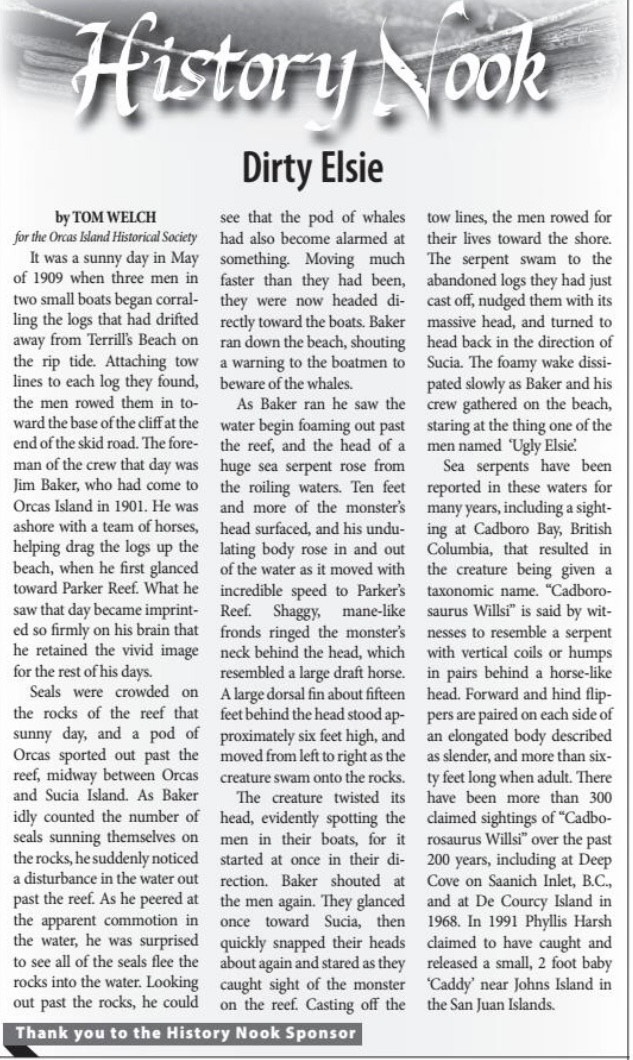
Copies of the original historical articles used by Mr. Welch were written by C. J. Colmery in “The Orcas Islander” and appear to have been written in the 1940’s era. These articles were provided courtesy of the Tom and Jennifer Welch collection. As of this writing, the exact date of publication is undetermined.
——————————————————————————–
As one would expect, this subject is fraught with controversy. Many sightings of the Cadborosaurus serpent have been dismissed as primitive Basking Sharks, Oarfish, Elephant Seals, floating logs and other likely sea creatures.
It is often suggested in such sightings that people are experiencing “pereidolia” defined by Merriam-Webster as:
“the tendency to perceive a specific, often meaningful image in a random or ambiguous visual pattern”.
Which means, people sometimes see what their mind creates.
That didn’t stop two top west coast marine scientists from publishing what may be the first thorough scientific journal on the Cadborosaurus.
In April of 1995, Dr. E.L. Bousfield and Dr. P.H. LeBlond and peers published Volume 1 of “AMPHIPACIFICA -Journal of Systemic Biology”. The entire, somewhat controversial journal discusses the Cadborosaurus “serpent” over twenty-five pages.
“AMPHIPACIFICA” takes a “deep dive” into the Cadborosaurus, with a fair amount of speculation involved.
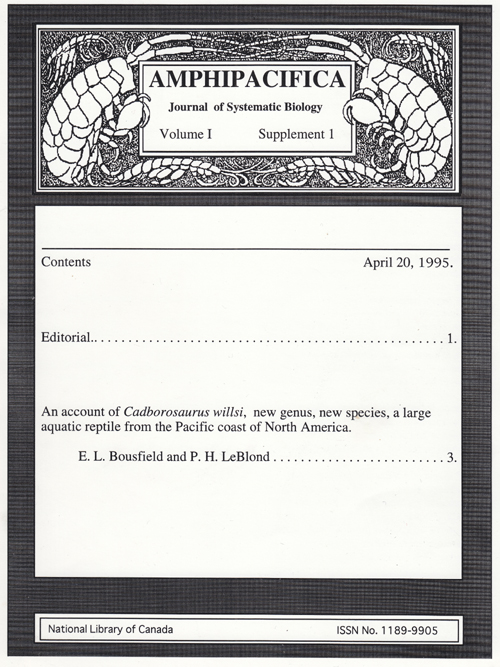
Here is a link to the PDF of AMPHIPACIFICA, from the British Columbia Scientific Cryptozoology Club (BCSCC) : http://cadborosaurus.ca/
AMPHIPACIFICA:
http://cadborosaurus.ca/Amphipacifica.pdf
Much controversy revolves around this publication, as we shall see.
Authors Bousfield and LeBlond label the creature (if it exists) in the vertebrate class “reptilia”, yet leave plenty of room to deem the animal a possible mammal, which is likely.
The authors place a great amount of evidentiary stock in a photo from 1937. In the photo, now called “The Naden Harbour Photo”, a whaling station in Canada displayed the carcass of a supposed young Cadborosaurus. The carcass had been retrieved from the stomach of a Sperm Whale that was being cut and processed. The whalers, very familiar with sea creatures, had no idea what the animal was as it did not resemble anything they had processed before.
Interestingly, Sperm Whales hunt at 300 to 1000 meters deep along the continental slope. Such whales are sometimes found to have huge suction cup scars from life-or-death fights with giant squids, which they prey upon. In “Discovering Cadborosaurus”, authors LeBlond, Kirk and Walton cite a Victoria Times article from 1933. In the article, a sea captain reported seeing such a sea serpent “fighting with a whale. The serpent had wound it’s body around the whale twice…”
With that account, we might assume that the whale and the Cadborosaurus might compete for the same prey, or in the case of the Naden carcass, a Sperm Whale may have eaten a very young “Caddy”.
Taking a close look at an imperfect photo, we see what is claimed to be “The Naden Harbour Carcass”:
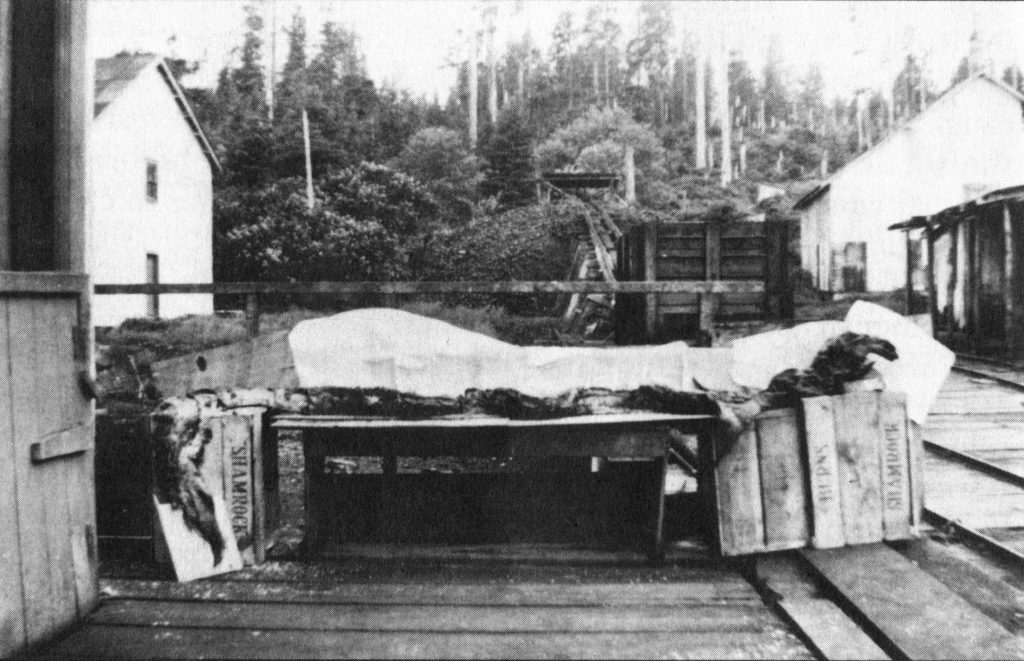
Credit: http://cadborosaurus.ca/Stills-Photos.html
What we see above from right to left, is a gaping mouthed head, a serpent body and on the far left a sort of finned tail. The carcass is propped up on a table and packing boxes. Behind it is a white sheet to provide contrast. The carcass soon disappeared, without scientific inspection.
Modern analysis can not confirm exactly what kind of creature it was, which caused two members of the AMPHIPACIFICA journal to write a dissenting editorial.
One of those two scientists, Dr. Craig Staude from The Marine Labortories in Friday Harbor Wa., responded to e-mail inquiries.
Dr. Staude was kind enough to answer many questions by e-mail about the Cadsborosaurus controversy, and prepared a statement for publication, which follows:
“1 August 2021
Dear John,
As you have discovered, I was on the editorial board of the journal Amphipacifica in 1995 when the formal description of the “sea serpent” Cadborosaurus willsi was published. At that time, co-editor Phil Lambert and I argued against the publication of that article, because we felt that the authors Ed Bousfield and Paul LeBlond had failed to present unequivocal evidence of its existence, and because the subject was outside of the normal content of our journal.
Our decision to oppose the publication was particularly difficult for me because Dr. Bousfield was a mentor who had helped launch my academic career. Ed was a recognized authority on the taxonomy of amphipod crustaceans, and like Dr. LeBlond, was a Fellow of the Royal Society of Canada with many publications to his credit.
Ed Bousfield had become fascinated by a collection of “Caddy” news clippings amassed by Dr. Clifford Carl, past director of the Royal British Columbia Museum. Ed found it hard to dismiss the numerous reports of sightings, and became convinced that the 1937 photograph from the Naden Harbor whaling station was sufficient proof of its existence. Yet Phil and I felt that the photo of a partly digested carcass from the stomach of a sperm whale was ambiguous and did not sufficiently support the detailed species description and extended discussion of the article. I should point out that the accepted practice for establishing a new species is to deposit a “holotype” specimen in a museum where it can be reexamined by other scientists. The Naden specimen had been discarded at the time, leaving only the photo to stand as the holotype.
What then should we make of the many local sightings of Cadborosaurus, including the 1909 Orcas Island sighting? While I’m hesitant to dismiss them, I realize that honest observers can misidentify objects on the water, especially when viewed briefly or under conditions of fog or unusual lighting. Marine mammals or eel-like fishes can fool the eyes. I once accompanied Ed Bousfield to interview a Caddy observer. Although I found that person to be sincere, their story was unconvincing. If in fact any of these sightings were of a true sea serpent, then why in the intervening years has there not been better evidence in the form of a high-resolution photograph or perhaps a stranded carcass. The local waters are among the most photographed marine habitats in the world. Nowadays nearly everyone carries a cell phone with a built-in camera, and tourists with telephoto cameras at the ready daily traverse these waters in whale-watching boats, ferries, or nature cruises.
Admittedly the sea still holds many secrets, so I cannot entirely rule out the existence of Cadborosaurus. I would welcome convincing proof to vindicate my late friend Ed Bousfield, but for now I must remain skeptical.
Sincerely,
Craig Staude
Friday Harbor, WA”
The AMPHIPACIFICA Journal drew scientific dissent from it’s publication in April 1995 through April 2012.
In a “Scientific American” article from April 16, 2012 titled “The Cadborosaurus Wars”, author Darren Naish attempts to debunk the entire subject. Naish refers to the editorial by Dr. Staude and another scientist recommending against publication, and suggests some of the sightings are of swimming deer or the Northern Elephant Seal.
Naish leaves a little “wiggle room” by writing:
“..please note here that I am not necessarily discounting altogether the existence of a marine vertebrate that remains unrecognized by scientists at large.”
“The Cadborosaurus Wars” – https://blogs.scientificamerican.com/tetrapod-zoology/the-cadborosaurus-wars/
The fact of the matter is that the “Naden Harbour Carcass” was of a creature that could not be identified by an experienced whaling crew, and a living witness spoke to it’s veracity in a 2007 interview.
Dr. Paul LeBlond told a reporter for “The Times Colonist” in 2016 “To convince a zoologist this is a real animal, you need that specimen that you can touch and look at and share. That’s the apex of reliability”.
We now see that the Cadborosaurus has been stuffed into a category shared by ghosts, Bigfoot, and UFO’s. Sightings occur on a regular basis, but “nobody has one in their garage”.
If there is such a serpent that travels the west coast from California to Alaska (if not world-wide), what could it be?
While the journal AMPHIPACIFICA originally places the creature in a class of reptiles, page 9 of the journal (As well as other sources) provide speculation that the creature could be a mammal.
The authors note the lack of “fur or subcutaneous layer of fat..” which might protect it from cold water.
Yet, if the Cadborosaurus is indeed a warm-blooded mammal, it may be capable of cold-water life.
The authors do refer to the similarities to the “Mesozoic plesiosaurs”, yet the creature is often said to have something resembling a flowing, hairy mane or large whiskers.
Sightings of Cadborosaurus detail the humps or loops of the body which undulate in a vertical fashion, like a caterpillar. This is a signature of a mammal, as snakes and fish swim with horizontal undulations.
Additionally, the creature is seen “blowing spray” when it surfaces (like a whale) and climbing on rocks while breathing air.
***
In a recent podcast Canadian journalist, explorer and researcher John Kirk described seeing both freshwater and saltwater serpents.
(https://podcasts.apple.com/ie/podcast/ep-043-john-kirk-sasquatch-history-and-lake-monsters/id1460805013?i=100046713681),
The freshwater serpent, sighted on Okanogan Lake has the unusual nickname “Ogopogo”. Kirk also sighted the saltwater serpent (Cadborosaurus) near the mouth of the Frazier River, both locations are in British Columbia, Canada.
Possibly due to the locations of human population, freshwater serpents seem to have consistent reports in the lakes of British Columbia.
In their book “Discovering Cadborosaurus”, authors Dr. Paul LeBlond, John Kirk, and Jason Walton describe freshwater serpent sightings.
In theory, various Pacific Northwest lakes were connected to the ocean by large rivers. This changed beginning in 1926 with the construction of dams.
One line of thought is that freshwater serpents originated in the ocean and followed fish runs up the river seasonally, only to eventually be trapped by the dams.
In “Discovering Cadborosaurus”, the authors suggest that the freshwater serpents have been sighted out of the water, moving on primitive legs.
The time period from the building of the dams to present is too short for evolutionary change, and freshwater serpents must be of a different lineage.
None the less, many features and behavior are very similar to Cadborosaurus.
Dr. Paul LeBlond has passed away, but in e-mail exchanges “Discovering Cadborosaurus” co-author and explorer John Kirk provided this excerpted comment regarding the lack of recent sightings of Cadborosaurus:
“There have not been any sightings for two years. This is not concerning yet, but the longer there aren’t any, the more worrisome it becomes. Climate change has affected ocean life and it is possible that with water temperatures rising around BC and Washington state, these animals are seeking colder water in Alaska.”
Co-author Jason Walton commented (excerpt) :
“Hi again John, that’s a great article, I had a look to see if there were any other sightings from the island in my files, but I haven’t been able to locate any, there were plenty of stories off the west coast in the early 1900’s of these serpent like creatures scaring the heck out of local fisherman, and making some dramatic appearances… one fellow here on Vancouver Island was known for chasing them around the Cordova bay and firing at them with his musket!..
..It’s been fairly quiet for the the last few years in regards to sightings, hopefully this Summer proves a bit more fruitful with people getting back outside and onto the beaches.”
Researcher Ken Gerhard has a fascinating book out titled “The Essential Guide To The Loch Ness Monster & Other Aquatic Cryptids”.
Gerhard is a proponent of the Cadborosaurus as ancient predatory whale theory.
In a brief but informative appendix in that book, Leland Hales describes the “Basilosaurus”, an apex predator that may have returned to the sea from the land around 41 million years ago. Fossilized remains have been found intact in Egypt, and one was even discovered in Alabama. Hales describes a small-brained animal that may have behaved like modern crocodiles. The jaw strength may have been over 3,600 pounds-per square inch.
Interestingly, it is noted that Basilosaurus had fluid-filled spinal vertebrae. While this would have ensured buoyancy, it would have also prevented deep dives.
It seems that if the Naden Harbour carcass is indeed a Cadborosaurus (and related to the ancient Basilosaurus), the Sperm Whale that ate it must have captured it in shallow seas.
Below is a skeleton of a variety of Basilosaurus, one of several hundred that have been discovered in Eygpt at “Wadi El Hitan “, or “Valley of Whales”:
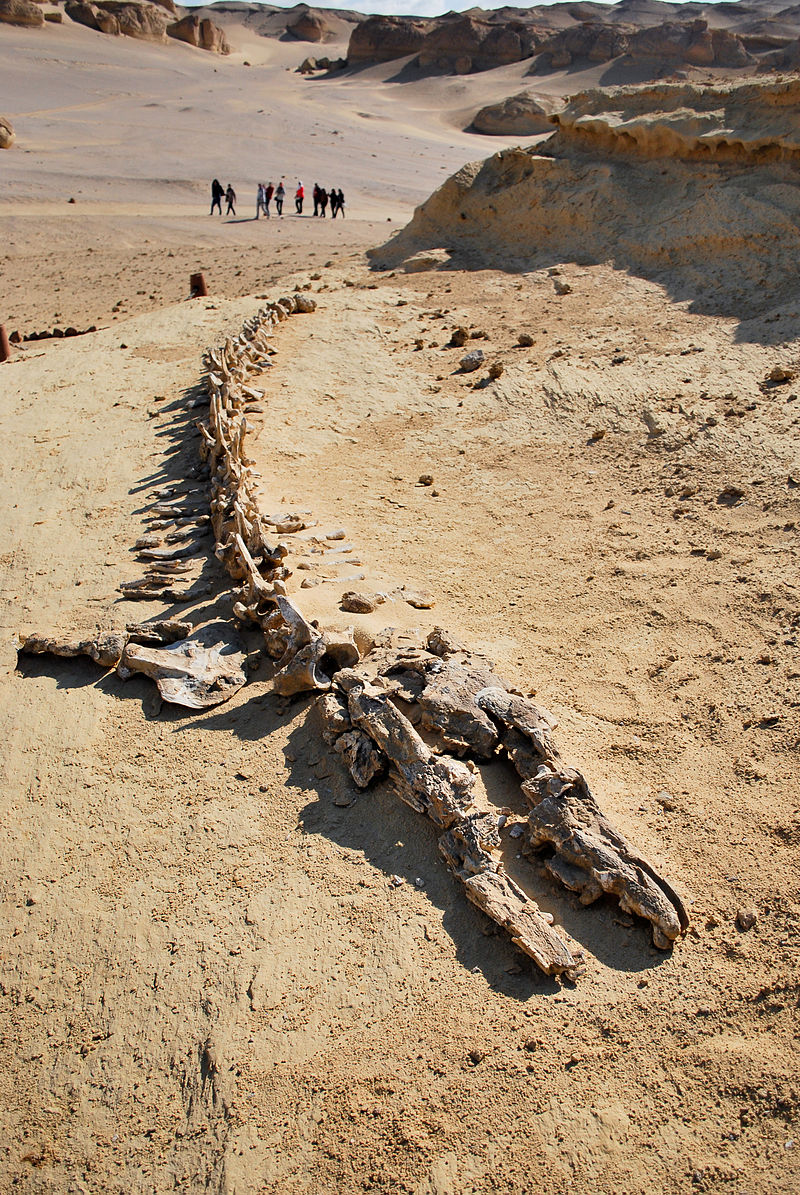
Credit: Wikipedia, B. ISIS
Does the Cadborosaurus exist?
This list on Wikipedia compiles at least 39 species thought to be extinct or unknown from fossil records:
“List of megafauna discovered in modern times”
https://en.wikipedia.org/wiki/List_of_megafauna_discovered_in_modern_times
The list includes animals that we are very familiar with in current times, and include the Mountain Gorilla, the Komodo Dragon, and the Giant Squid.
We now take for granted the existence of these creatures, which was unthinkable before their fairly recent discoveries.
The evidence for Cadborosaurus by sightings and the Naden Harbour Carcass photograph is somewhat convincing. The sighting on Parker Reef off the North Shore of Orcas Island predated published sightings in Canada by decades. Nearly every sighting shares the same characteristics, such as vertical undulations, horse-shaped head, and location of sightings.
The legend of the sea serpent in the Pacific Northwest goes deep into Native tribal history, and is depicted in rock petroglyphs and the carved Skagit River Atlatl pictured in this article.
Indeed, a small, 2-foot baby Cadborosaurus was claimed to have been captured in 1991 by Phyllis Harsh at John’s Island in the San Juan Islands in Washington State.
The latest sighting out of nearly 300 appears to have been in 2019 in Port Townsend, Wa., at this link for BCSCC (Sightings): http://cadborosaurus.ca/Sightings.html
In the words of an unknown researcher, “If such sightings are hoaxes or mistaken identification, they must all be hoaxes or mistaken identification”, because if there is one true sighting, whether it is of Cadborosaurus, Bigfoot, Ufo’s or another mysterious entity, then that invalidates all doubts.
As marine scientist Dr. Craig Staude of the Friday Harbor Marine Labs wrote,
“Admittedly the sea still holds many secrets, so I cannot entirely rule out the existence of Cadborosaurus. “.
FURTHER REFERENCES
AMPHIPACIFICA http://cadborosaurus.ca/Publications.html
Discovering Cadborosaurus (LeBlond, Kirk and Walton – Hancock House press)
The Essential Guide To The Loch Ness Monster & Other Aquatic Cryptids
(Ken Gerhard, Crypto Excursions, San Antonio Texas)
Special thanks to Dr. Craig Staude, Jennifer Welch, John Kirk, Jason Walton, The British Columbia Scientific Cryptozoology Club, The Island’s Sounder, The Orcasonian, Loren Coleman (For supportive advice) and others that have helped
– John Titus

